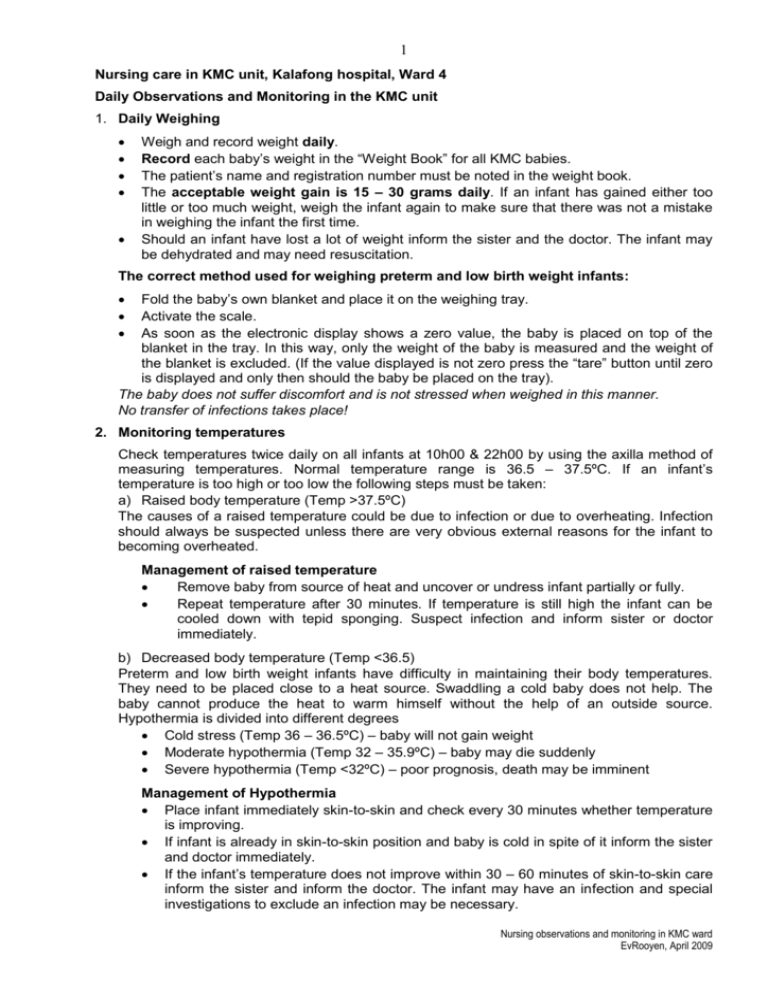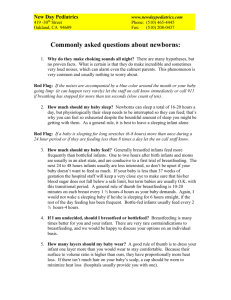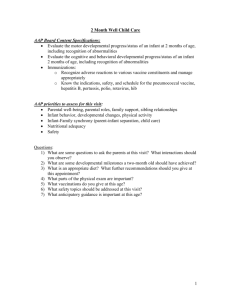Nursing care in KMC unit, Kalafong hospital, Ward 4
advertisement

1 Nursing care in KMC unit, Kalafong hospital, Ward 4 Daily Observations and Monitoring in the KMC unit 1. Daily Weighing Weigh and record weight daily. Record each baby’s weight in the “Weight Book” for all KMC babies. The patient’s name and registration number must be noted in the weight book. The acceptable weight gain is 15 – 30 grams daily. If an infant has gained either too little or too much weight, weigh the infant again to make sure that there was not a mistake in weighing the infant the first time. Should an infant have lost a lot of weight inform the sister and the doctor. The infant may be dehydrated and may need resuscitation. The correct method used for weighing preterm and low birth weight infants: Fold the baby’s own blanket and place it on the weighing tray. Activate the scale. As soon as the electronic display shows a zero value, the baby is placed on top of the blanket in the tray. In this way, only the weight of the baby is measured and the weight of the blanket is excluded. (If the value displayed is not zero press the “tare” button until zero is displayed and only then should the baby be placed on the tray). The baby does not suffer discomfort and is not stressed when weighed in this manner. No transfer of infections takes place! 2. Monitoring temperatures Check temperatures twice daily on all infants at 10h00 & 22h00 by using the axilla method of measuring temperatures. Normal temperature range is 36.5 – 37.5ºC. If an infant’s temperature is too high or too low the following steps must be taken: a) Raised body temperature (Temp >37.5ºC) The causes of a raised temperature could be due to infection or due to overheating. Infection should always be suspected unless there are very obvious external reasons for the infant to becoming overheated. Management of raised temperature Remove baby from source of heat and uncover or undress infant partially or fully. Repeat temperature after 30 minutes. If temperature is still high the infant can be cooled down with tepid sponging. Suspect infection and inform sister or doctor immediately. b) Decreased body temperature (Temp <36.5) Preterm and low birth weight infants have difficulty in maintaining their body temperatures. They need to be placed close to a heat source. Swaddling a cold baby does not help. The baby cannot produce the heat to warm himself without the help of an outside source. Hypothermia is divided into different degrees Cold stress (Temp 36 – 36.5ºC) – baby will not gain weight Moderate hypothermia (Temp 32 – 35.9ºC) – baby may die suddenly Severe hypothermia (Temp <32ºC) – poor prognosis, death may be imminent Management of Hypothermia Place infant immediately skin-to-skin and check every 30 minutes whether temperature is improving. If infant is already in skin-to-skin position and baby is cold in spite of it inform the sister and doctor immediately. If the infant’s temperature does not improve within 30 – 60 minutes of skin-to-skin care inform the sister and inform the doctor. The infant may have an infection and special investigations to exclude an infection may be necessary. Nursing observations and monitoring in KMC ward EvRooyen, April 2009 2 3. Monitoring infants’ breathing Check the infants breathing rate at least twice a day. (Normal 40-55 breaths per minute) Check also whether they are breathing comfortably with no noticeable effort. Neonates’ airways are very small and may very easily become blocked. a) Infants receiving oxygen via nasal catheters should also be checked for blocked noses. Infants can only breathe through their noses. If their noses become blocked they may collapse or develop apnoea. The infants in the KMC unit receive oxygen that is not humidified and this may dry out the airways and cause blockages. To prevent noses becoming blocked, each infant on oxygen must receive one drop of saline nose drops in each nostril every 3 hours. The mothers can instil the drops before each feed. If an infant’s nose is blocked or the baby has difficulty in breathing call the sister to carefully suction the baby’s nose. Instil saline drops while suctioning. If this does not improve the infant’s breathing call the doctor and continue administering oxygen. b) All infants should be assessed whether they are in need of oxygen by doing daily pulse oximeter measurements. The oxygen saturations should be above 85%. If the saturations fall below 85% or if the infant develop tachypnoea (breathing rate >60/min), inform the sister and place infant on oxygen. Also inform the doctor. c) An infant who is receiving oxygen should have twice daily pulse oximeter measurements. The saturation should never be more than 92%. Decrease the oxygen flow until the saturations are below 93%. High oxygen saturation levels may cause blindness in premature infants. Oxygen flow should also not exceed 2 litres flow when using a nasal cannula. On weaning an infant from oxygen the pulse oximeter measurements should be performed frequently during the day. The oxygen saturation of infants being weaned should be from 86 – 92%. If it drops below 85% and stays below 85% saturation the infant should be placed back on O2 therapy. To wean an infant from oxygen and to see whether he can manage without oxygen the following must be done: The oxygen flow meter must be closed and the tube must also be disconnected from the oxygen flow meter. (There is often a leakage of oxygen through the flow meter if the tube is not disconnected.) When a decision is made regarding the weaning of oxygen, always inform the mother especially if the oxygen is stopped completely. The mother can keep watch to see if the infant does not develop tachypnoea, cyanosis or apnoea. Wean according to the Oxygen Weaning Standing order. 4. Monitoring the heart rate The normal heart rate range is 115 – 185. If the heart rate is too slow or too fast inform the sister and the doctor. Causes for a slow heart rate – hypothermia, infection, apnoea etc Causes for a fast heart rate – hyperthermia or fever, infection, heart failure etc 5. Monitoring urine and stools a) Infants should have about 6 wet nappies daily. If the baby does not pass urine it may be because it does not receive enough feeds and is becoming dehydrated. b) Breastfed infants can have 7 stools in one day or 1 stool in 7 days. As long as the baby does not have a distended abdomen you can reassure mothers who are concerned when their babies have not passed any stools for a couple of days. If a baby passes bloody stools, keep the nappy and stools and call the sister and doctor. This may be the first symptoms of a serious life threatening condition called necrotising enterocolitis. If a baby develops diarrhoea keep the nappy and call the sister and doctor. Nursing observations and monitoring in KMC ward EvRooyen, April 2009







